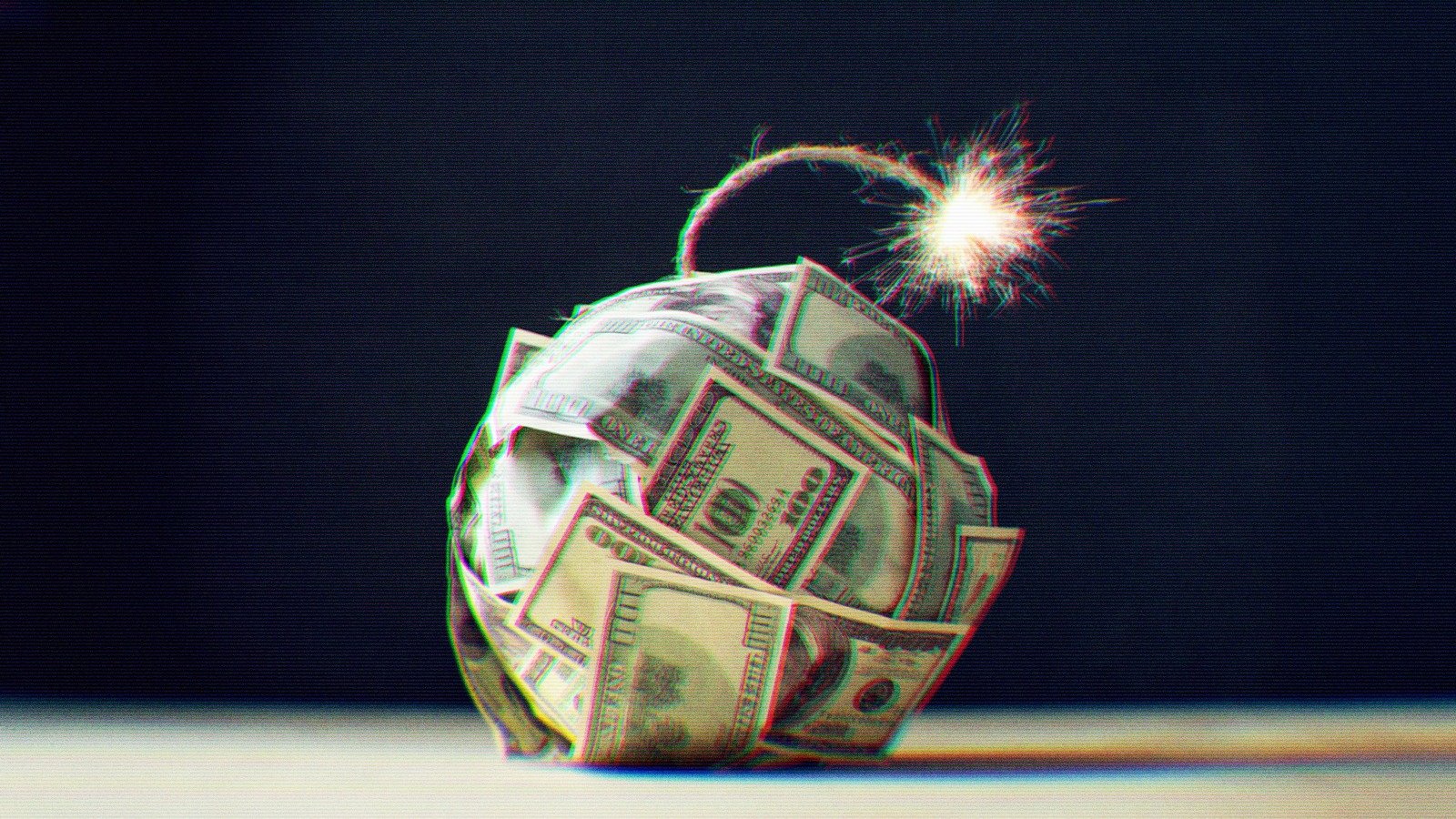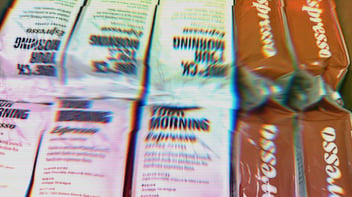Income Inequality in the U.S.
Why You’re Struggling.
 Image Description: A ball of $100 bills with a lit fuse on the end.
Image Description: A ball of $100 bills with a lit fuse on the end.
Income inequality is often spoken about but still widely misunderstood. There’s a reason why the vast majority of Americans are barely getting by while the top income earners continue to pull ahead. We’re entering a new phase of capitalism, however, and it stands to affect even some of those who were previously untouched by economic downturns. There is trouble brewing that threatens the preeminence of the U.S. Dollar as the cheap and easy money era comes to a grinding halt. Few of the old tools in the Fed and Treasury toolkit will be as effective as they once were, and the Trump administration seems determined to build a private shadow central banking system that will make matters worse for everyone but the uber-wealthy.
We’ve finally entered the inequality matrix where everything flips on its head.
If you feel like you’ve done everything in your power to get ahead and yet you’re treading water or under it, you’re not alone. In fact, you’re in good company with about 90% of America. But why?We know at this point that inequality is a thing. We have a sense that it’s real and not good for society. But how did it get to be this way? Did the billionaires really have a cheat code? Are we less industrious and hard-working than our parents and grandparents as the powers that be would have you believe? Is it the fault of the politicians who shipped our jobs overseas? Is it the debt we’ve saddled future generations with?
For every question related to inequality there is blame that ranges from it’s your fault, to immigrants, Democrats to Republicans, Wall Street to China. But it’s a lot more straightforward than that and I think it’s time to level set on inequality and be honest about how things got this way.
The Current Snapshot of the Economy
As a preamble I am going to share a couple of relevant current charts to lay the groundwork; three quick charts that were just released by the Conference Board that illustrate what we’ve been saying for a while now. Then I’m going to share the only chart that matters in this moment to show you where all the money went before we put it in historical context.
The first is the June Leading Economic Index (LEI) chart.

You can see there are two lines. The Blue line is the LEI. (If you have color distinction troubles, it’s the one that is declining at the tail end.) The other line is the coincident indicator. The coincident line measures economic health at the current moment. The regular LEI measures where the economy is headed.
The easiest way to think about it is that the Coincident line measures inputs from the business community and the consumer to indicate conditions at this moment. You can see the economy hasn’t bottomed out as it did when the two lines dropped almost simultaneously during COVID and the Global Financial Crisis (Great Recession). Those were collapses, which is why the lines moved tightly together. Typically, the LEI diverges prior to a recession (as it did in the dotcom bubble) because the LEI typically serves as a predictor.
The early divergence of the LEI compared to the Coincident line supports what we’ve been saying for a while. The economy is eroding from the bottom up. The business community and those responsible for the greatest amount of consumption in the economy have continued to engage in normal business and consumer activities so it’s taking a while for the data to show up more broadly. But the steep decline in the LEI indicates that it’s beginning to catch up as the future economic health indicators begin to crumble further up the ladder.
Now, in this next chart you can see red lines—or the horizontal line in between the dips that indicates when formal recession signals were called according to the indicators.

What’s interesting about this is that you notice the most recent horizontal recession signals don’t correspond with a technical recession. So it’s plain to see what happened in the dot-com bubble aftermath, the Global Financial Crisis and COVID briefly. But we had high signals during the Biden inflation crisis that muted slightly in the beginning of the year, but now we’re back in that territory again. This type of volatility in LEI signals further illustrates how the American economy is struggling to regain its footing and find prior normative levels.
One of the reasons for this is that we’re still dealing with the massive upheaval from COVID, inflation shocks, Fed policy changes with respect to money supply and fluctuating interest rates. In many ways the macro economic picture has fundamentally changed, but our approach to the numbers hasn’t. Now add to the mix exploding deficits, forced government layoffs, unnecessary inflation from tariffs leading to the “Sell America” trend of late and the loss of benefit and entitlement programs and it makes sense why some of this hasn’t returned to normal.
Of course, there’s a bigger picture but before we get there one more important finding from the Conference Board.

The headline is important here. “A strong rally in stock prices was not enough to offset negative impacts from weak consumer confidence and new orders.” So what this means is equity market activity is considered in these figures because there is wealth accumulation and income associated with market gains and that does affect how some people feel relative to their retirement accounts, dividend gains (if they rely on the market for income) and the general narrative about markets.
Now, remember our mantra that the market is not the economy. And that holds true here, so it’s more relevant to look at the figures that are dragging on the index. Specifically the hard numbers and not sentiment data like consumer expectations. The two biggest drags on the LEI are new orders and unemployment claims. There are fewer orders and unemployment is creeping higher.
Those are the real numbers that impact the real health of the economy on a macro level. A certain, very vocal segment of the boomer generation is living high on the hog from their investments, and those are the people who are on the business channels and writing the op-eds every day telling you the economy is fine. Meanwhile, the business and manufacturing communities are sitting on inventory they front loaded at the beginning of the year to get ahead of tariffs, but the new orders aren’t coming in.
The fact that inflation is already in the numbers despite the fact that most producers are still working down pre-tariff inventory shows how core prices will continue to rise, despite the fact that the consumer has already begun to cut back. This is the beginning of the negative feedback loop where sentiment is actualized in the data. The worse the consumer feels, the more they pull back. The more they pull back, the more the producers increase prices in the short-term to offset the drop in sales. Before they reduce prices to match the market, producers will reduce headcount to try and make the numbers work and maintain their bottom lines. But it never really works out this way.
Around and around we go like water in the toilet bowl until it bottoms out and slowly begins to refill again.
Inflation vs. Inflated
Okay, so that’s the boring stuff out of the way. The reason I wanted to start there is to illustrate how shaky the foundation of the economy is, and also to show how stock market gains contribute to the “healthy economy” narrative. But these are false positives if prices are going up, more people are getting laid off or unemployed for longer and interest rates on credit cards, home mortgages and auto loans aren’t coming down.
So now. The important chart I wanted to show you. We’ll jump back and forth between it to fully contextualize it but here’s the first look.

AI-generated with Perplexity using multiple data sources.
These are compounded rates of annualized growth of a few asset classes mapped against real wage growth and total dollars in circulation from 1978 until today.
These figures are averages from major indices and adjusted for inflation to smooth the data. (Thus the straight lines.) I chose 1978 as the starting point because it relates to a few key events. First off, Gold was an investible commodity by this time after Nixon pulled the dollar off it as a peg to value. This is also around the start of the stagflation crisis, which fundamentally altered monetary policy in this country and kicked off the modern era of massive Fed intervention and floating fiat currency.
At the top you have the value of the S&P 500 with annualized returns of around 8% and compounded over the period. Below that is the dotted line of currency in circulation. Below that you have the value of art—using something called the art market index—and Gold, which track pretty closely together. Then at the bottom you have home and auto prices pretty close together with real wage growth all the way at the bottom.
So what matters most to the average American not living on investments in the stock market, gold or art is obviously the very bottom. That’s where most people store their wealth if they’re lucky, because 35% of the population doesn’t own a home. So cars and homes are the two main stores of wealth for the average American. What’s troubling about bottom of the graph is that heading into the 21st Century wages kept pace with home prices and auto prices. So even though speculative asset classes began to dramatically pull away from the value of wages, it remained feasible to purchase a car or a home in the same income-to-debt ratio as prior generations. But even these asset classes began to increase relative to wages.
And here’s the thing about these assets. In absolute terms, they are incredibly expensive. So when home and auto prices increase relative to earnings it’s not like bubble gum went up and put a dent in your chewing gum budget. Relative increases to these major assets have an outsized impact on one’s budget and ability to manage debt. That’s why the American debt burden has risen substantially every year for decades.
On the other hand, the increase in compounded value for assets like stocks, art and gold is directly correlated to the increase in the money supply. I’ll explain…
It’s Not Your Fault
The reason it’s harder for young people to participate in this economy is because things like homes are the basis of wealth building for most people, but for the wealthy they’re just another asset class. And nearly four out of ten Americans don’t even own a home, so they’re locked out of this particular asset class if it keeps rising relative to their wages. And if interest rates remain high it gets even harder.
But I don’t want to get into the weeds on rates and treasuries, I just want to talk in absolute terms about dollars available in the economy and who has them.
When Nixon pulled the dollar off gold it meant the Treasury was unleashed. It could print money to run fiscal deficits, purchase assets, shore up Wall Street during financial crisis after financial crisis and generally put more money in the system to boost economic growth and activity. But the mechanisms for this are usually at the central bank and corporate level.
So money flows ultimately into central banks, corporate debt instruments and equities because they’re built to absorb these flows. On rare occasions the government gives money directly to citizens through unemployment benefits, tax cuts, tax credits or stimulus funds. But by and large the money flows to institutional sources.
Now here’s where it gets tricky but interesting.
Sometimes the government stands on both sides of money flows. They can print money and buy it back. They can lend money to banks and investment banks, then allow them to purchase treasuries with higher returns than the interest on the loans, thereby creating a financial arbitrage. After the housing market collapse, the government purchased toxic assets from banks so they didn’t have to absorb massive losses due to their irresponsible behavior.
You and I don’t get to do these things, but they do. So as we went hog wild sending gobs of cash into the system from Nixon forward, institutions as middle men—from banks to big companies—stood in the middle gobbling it up and putting it to use. And as the performance of these banks and companies increased as a result of easy money, they loosened the compensation and regulatory standards to incentivize executives through stock performance as we covered in our buyback essay.
But here’s the thing. There comes a point when money doesn’t do anything more for someone than cover the basics. That’s true for people and it’s true for corporate entities.
And you can think about your own life and budget. If the cost of running your household is $8,000 per month for rent or mortgage, car payment, health insurance, education, food, entertainment, utilities, etc.—let’s say you’re in the upper middle class with a monthly household income of $10,000 after taxes. Maybe you use the extra $2,000 for a vacation fund. To save for a big purchase down the road. College. Retirement. Entertainment. Whatever. It’s good to have a cushion but it still doesn’t leave you with a lot of wiggle room.
Now let’s say you have the same $8,000 a month in expenses but you bring in $50,000 a month after taxes. You probably spend pretty casually. All those other items get bigger. More vacations. Dining out more often. More stuff. And you’re probably sitting with a financial advisor who’s putting some away for college, paying down debt faster, investing in stocks and bonds and maybe a little bit of crypto. Maybe.
Now. Same $8,000 per month but you’re a millionaire. You bring in $100,000 a month after taxes. You’re doing all the same things but on steroids, and now with that extra something-something at the top, you’re gambling a bit. You’re buying NVIDIA. Bitcoin. Gold. A vacation home. And something Jim Cramer told you to buy earlier that day.
Turns out if you’re that guy, things have been really good because your money lives at the top end of our inequality chart where everything compounds more and faster. Stocks are ripping, gold is up and you might have just become a Bitcoin millionaire. You’re loving life and thinking you’re a genius. Now you’re buying art, another vacation home and might have even turned that home into an investment vehicle by renting it out six months of the year. Life is good.
I’m not throwing shade your way if this is your life. But it’s important to recognize that those assets that contribute to wealth have been artificially and consistently inflated by the U.S. government pouring money into investment banks and corporations, and fueling the rise of speculative asset classes and commodities as a result.
But now everything is more expensive because of these artificially inflated asset classes. If you’re a young person just starting out, try jumping in at this point. Can’t be done. And that’s why Millennials have fewer assets, Gen Z can’t find a good paying job, and Gen Alpha might as well move to India or Indonesia if they want to jump on this ride at the beginning.
Now take the individual earner to the corporate realm and the inequality issue is magnified, though it’s all tied together. Corporate America continues to hoard cash and reinvest it in either themselves or, what’s happening now—speculative assets. Hence the rise of Bitcoin and gold. So just like how the household that makes so much money—beyond paying for essentials and sound investments—is investing in art, vacation homes, expensive collectibles and other non-essentials, corporations are too.
You see, the easy wins are gone and now we’ve printed more money than even they know what to do with, because the real economy isn’t absorbing it. Not through shareholder returns as evidenced by increased price-to-earnings ratios or through the bond markets, which refuse to quiet down and are pressing ever higher because the rest of the world is beginning to recognize that we’ve reached peak money-to-asset ratios.
Now here’s the thing, I fully expect these speculative asset classes to continue going up. The sky is the limit for Bitcoin, and gold as well. But not for the reasons you might think. These things are increasing because the U.S. Dollar is no longer the safe haven it once was. The Trump administration knows this and so does every other central bank in the world. That’s the part I want you to remember for future essays, because there’s trouble brewing in the global economy like we haven’t seen for generations and plenty of vultures circling. Stay tuned for more.
The “Post Fundamentals” Era
We’ve said over and over that the capitalist system is designed to boom and bust and the bust comes every seven to ten years like clockwork. Only now we’re moving beyond what capitalism has done in its brief history because the fundamental models are breaking down.
It’s painfully apparent that the average American has been living in a recession since the start of this millennium. It’s why consumer credit is at an all time high. Why most people don’t have enough to retire. Why younger people aren’t buying homes. Why you’re treading water or just below.
Capitalism was designed to be heavily regulated and to have much of the surplus flow to the general public to account for “general welfare.” Those are the words of Adam Smith and the founders of this Republic. But in the post Bretton Woods era from Nixon on, the system has been trending in the opposite direction. Slowly, steadily regulations have disappeared. Capital accumulation has gone to the top and the gains have been compounded by the very deregulatory actions of the policy makers. Both parties are complicit because we were the holders of the most valuable commodity on planet earth: the dollar.
So long as the dollar maintained its value and could be converted to real assets—homes, cars, automobiles, food, gas, whatever—at rational exchange rates, then it meant the absolute number of dollars in your pocket determined how many of these things you had. If you were just a wage earner over the past 47 years, you made barely enough. If you were middle to upper-middle class you had more than enough.
And if you had a silly amount of money you had the ability to take a few risks in assets like stocks that were never actually risky, because they built a system designed to make those numbers go up all the time, even if the performance of the companies those stocks represented didn’t warrant it.
That, my friends, is a ponzi scheme. And ponzi schemes rely on there always being enough fresh money coming into it to prop it up.
So most of us didn’t participate. It is what it is. But it means downturns are getting harder and harder on the majority of Americans. So believe it or not, the next crash won’t just affect the 90% who didn’t participate in any of this. It’s finally going to smash that next level up. The top five to seven percent who have more than enough to live well and save for a rainy day but not that next level of ‘Fuck You’ money to gamble with.
Right now the Trump administration is trying to stave off the inevitable debasing of the dollar while simultaneously trying to debase the dollar because their interest rate and money supply strategies are directly at odds. In the background they’re setting themselves up for the stablecoin era to put the dollar on a ventilator and keep the experiment going for a while longer. But doing this while ripping out safety nets for tens of millions of Americans, investing in job-killing AI, inviting inflation through punitive tariffs and literally forcing the world to reorient supply chains around us and look for alternative currencies, means they’re going to blow out the system from the bottom up.
What they’re banking on, however, is that the new global stablecoin monetary system will create a new private and opaque central banking system designed to pour all that excess money, no matter what denomination it started in, into private hands and away from nation states. Welcome to the new feudal era.
There’s your baseline for things to come and the black and white—and red, yellow, green and blue—explanation for why you’re not just in the Trump recession, you’ve been in one all along.
Here endeth the lesson.
Max is a political commentator and essayist who focuses on the intersection of American socioeconomic theory and politics in the modern era. He is the publisher of UNFTR Media and host of the popular Unf*cking the Republic® podcast and YouTube channel. Prior to founding UNFTR, Max spent fifteen years as a publisher and columnist in the alternative newsweekly industry and a decade in terrestrial radio. Max is also a regular contributor to the MeidasTouch Network where he covers the U.S. economy.


